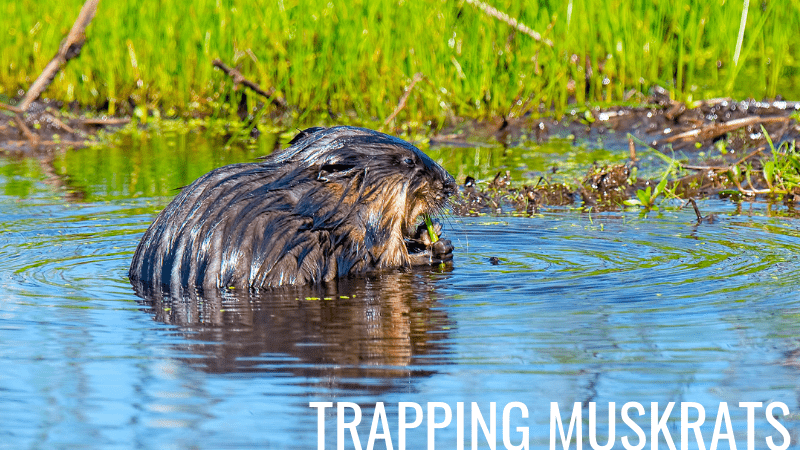How to Trap a Muskrat in a Pond (Best Method)
Pond Academy is reader-supported. Buying through links on our site may earn us an affiliate commission. As an Amazon Associate I earn from qualifying purchases.
While muskrats might look cute and innocent, they can cause a lot of damage to your pond.
And oftentimes, the damage isn’t obvious until serious destruction has occurred.
In this guide, you’ll learn how to trap a muskrat in a pond safely and humanely.
Plus, get tips to keep these pests from coming back.
![]() IMPORTANT
IMPORTANT
Ensure you have read and fully understand all local relocation and muskrat trapping laws before capturing them in live traps.
How to Trap Muskrats With a Live Trap

1) Choose a Live Muskrat Trap
The most ideal live muskrat trap will feature 1 or 2 doors, and measure at least 30-40 inches long. Both single and double door models offer the same effectiveness, with each having its own advantages, including:
Single Door Trap
- Provides superior bait protection
- Easier for large animals to enter
- Favored by professionals
Double Door Trap
- Enables one or both doors to be opened
- Two doors equal increased catch rate
- Allows users to see through the trap
- Increased visibility calms frantic animals
2) Place Your Trap
There are two locations to consider when placing a muskrat trap:
- Muskrat Run: Muskrats travel along the shoreline in shallow water creating a “runway” in the mud. These runs typically lead between the tunnel entrance to their den to a feeding spot. Along this run is an ideal place to set your trap.
- Muskrat Burrow: The best place to place a trap for catching muskrat is directly outside of their burrow. Typically a burrow entrance measures around 6-8" in diameter, located near a waterway's bank or outside wall. Muskrat runs commonly lead to the entrance of a burrow.
![]() Tip
Tip
Place your trap on a level surface to provide the best operation of the trigger and close mechanism. Stake the trap to the ground to ensure it remains secure and level.
3) Bait the Trap
While you can buy muskrat trap bait, apples and starchy root vegetables serve as excellent forms of bait for your trap. And they are cheap and readily available.
Just keep in mind, you must properly position the bait in order to force the muskrats to engage the trigger. Otherwise, you will have muskrats snagging your bait, without actually being trapped. The ideal location is 2-3 inches from the rear of the cage, but not on the trigger plate itself.
![]() Tip
Tip
Wear gloves when handling the bait as to not transfer your scent to it.
4) Set Your Muskrat Trap
Face the door of your trap toward the directions muskrats utilize for travel, following the manufacturer's instructions accompanying your trap. It is vitally important that nothing sits in the way of the trigger, or close mechanism. Clear out any brush or debris that may sit underneath the trigger pan once it has been set.
5) Check the Trap Frequently
It's important to monitor your trap on a regular basis, as trapped muskrats may become unpredictable, anxious, or hungry. For these reasons, it's best to never leave muskrat traps unattended.
6) Catching a Muskrat
Once you catch a muskrat, there are some helpful tips in regard to animal relocation.
- In order to prevent startling the animal, approach calmly.
- Avoid contact with the muskrat by wearing heavy gloves and holding the trap away from your body.
- Cover the trap with a cloth or towel during transport, in an effort to keep the muskrat calm.
- Relocate your muskrat to another habitable wetland environment if local laws permit, at least 5 miles away from the trapping location.
Get Our Best Pond Tips Sent to Your Inbox for Free!
Join thousands of others and learn from our decades of pond building and maintenance experience! Your pond will thank you!
By subscribing you agree to receive emails from PondAcademy.com. We will always respect your privacy and you can unsubscribe at any time.
How to Get Rid of Muskrats for Good
Once you’ve removed any muskrats in or near your pond, it’s a good idea to make the habitat unlivable for these rodents so they don’t come back.
Use a Pond Liner
A pond liner, which is essentially a type of sheeting that serves as the foundation of your pond, will deter a muskrat's natural instinct to burrow, leading them to seek housing elsewhere.
The only issue that may arise when installing a pond liner is the management of preexisting muskrat burrows. Alternatively, as long as you've ensured the burrow is free of inhabitants, you can cover burrows with wire mesh, or fill them with gravel.
Install Pond Netting
For small bodies of water, such as an ornamental fish pond, the use of pond netting may be more beneficial. These mesh-style nets will prevent muskrats, frogs, turtles, small birds, and, depending on the size of the netting, some insects from entering your pond.
Simply secure the net on each corner around the pond and let the net rest on the surface of the water, essentially making it invisible while protecting your pond.
Install Fencing
Placing a small fence around your pond or lake may also serve as a simple deterrence against muskrats. Overall height won't be too important, as muskrats aren't skilled climbers. The width between fence posts should be your biggest concern, as well as the depth in which the fence is dug. Ensure that the fence goes at least 6 inches or more underground, to prevent digging. While this method won't prevent birds or insects from getting in, it will keep muskrats, toads, frogs, and turtles out.
Natural Muskrat Repellents
You can find a wide variety of over-the-counter sprays, which can be utilized on plants, in addition to the surrounding area of your pond or water garden. This will also serve to prevent muskrats from eating your pond plants. The spray provides an unpleasant taste or smells that muskrats tend to avoid. The downside to natural repellents is that they require frequent applications.
Remove Sources of Food
There are additional lengths that may be taken to keep muskrats from setting up camp, and the removal of their favorite food sources is a good start.
This method works well for small ponds, as you can easily remove any aquatic vegetation from around a pond without disturbing the entire ecosystem (which isn't so easy with large lakes). Start by removing any cattails, pondweeds, bulrushes, and sedges in or around your pond.
If you are a plant lover and wish to keep your aquatic plants in your pond, simply remain vigilant about keeping the plants trimmed back.
Hire a Professional
Individuals frustrated with a rather substantial muskrat population may need to seek the help of a professional. Between the Department of Natural Resources, pest control, or a nuisance wildlife control operator, you are sure to find a professional that's more than willing to trap and remove muskrats on your behalf.
Are Muskrats Bad for a Pond?
In terms of natural areas, muskrats (Ondatra zibethicus) serve as an important species, especially in terms of keeping the aquatic plant population under control. Muskrats also serve as a valuable food source to a variety of animals.
The old dens of muskrats are beneficial living quarters for frogs, turtles, snakes, as well as birds. Basically, the question of whether a muskrat is bad for a pond is completely dependent upon your point of view, as well as your goals.
Muskrats do, however, tend to create issues in terms of urban areas toting decorative ponds and lakes. They often damage shorelines while burrowing to nest, as well as manmade structures often found on shores, such as dams and dikes.
Homeowners also dislike that they eat the plants and fish stocked in ponds and lakes. The only time this may be beneficial, is if you are managing an invasive vegetative growth such as arrowhead, cattails, or water lilies.
These rodents can also host a variety of parasites and bacteria which may, unfortunately, be transferred to other inhabitants of lakes and ponds. One disease, in particular, found among muskrats, includes tularemia. This may kill muskrats, and also pass to humans where it requires treatment. When handling muskrats, always make sure to wash your hands in hot, soapy water, immediately after handling.









